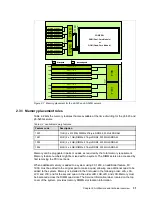
36
IBM System p5 520 and 520Q Technical Overview and Introduction
You also have the option to make the internal Ultra320 SCSI channel externally accessible on
the rear side of the system by installing FC 4275. No additional SCSI adapter is required in
this case. If FC 4275 is installed, a second 4-pack disk enclosure (FC 6574 or FC 6594)
cannot be installed, which limits the maximum number of internal disks to four. Slot 5 cannot
be used when FC 4275 is installed. For more information about the internal SCSI system, see
2.7, “Internal storage” on page 41.
2.6.3 Integrated RAID options
The p5-520 and p5-520Q can be configured with the optional SCSI RAID daughter card
(FC 1907) that plugs directly on the system board or with a Dual Channel Ultra320 SCSI
RAID adapter (FC 1913) to drive one 4-pack disk enclosure.
RAID implementation requires a minimum of three disk drives to form a RAID set.
These are different internal RAID options that you can consider:
Install FC 1907 and up to 4 disk drives in the default 4-pack disk enclosure. This allows
RAID capabilities within a single 4-pack.
Install FC 1907 and a second 4-pack disk enclosure (FC 6574). This allows RAID
capabilities across two 4-packs.
Install FC 1907 (or later) and the Ultra320 SCSI 4-Pack Enclosure for Disk Mirroring
(FC 6594). Install the PCI-X Dual Channel Ultra320 SCSI RAID adapter (FC 1913) and
the SCSI cable (FC 4267), which connects the PCI-X adapter to the optional 4-pack disk
enclosure. This RAID configuration provides increased reliability over first and second
options
2.6.4 iSCSI
iSCSI is an open, standards-based approach by which SCSI information is encapsulated
using the TCP/IP protocol to allow its transport over IP networks. It allows transfer of data
between storage and servers in block I/O formats (that is defined by iSCSI protocol) and thus
enables the creation of IP SANs. iSCSI allows an existing network to transfer SCSI
commands and data with full location independence and defines the rules and processes to
accomplish the communication. The iSCSI protocol is defined in iSCSI IETF draft-20. For
more information about this standard, see:
http://tools.ietf.org/html/rfc3720
Although iSCSI can be, by design, supported over any physical media that supports TCP/IP
as a transport, today's implementations are only on Gigabit Ethernet. At the physical and link
level layers, iSCSI supports Gigabit Ethernet and its frames so that systems supporting iSCSI
can be directly connected to standard Gigabit Ethernet switches and IP routers. iSCSI also
enables the access to block-level storage that resides on Fibre Channel SANs over an IP
network using iSCSI-to-Fibre Channel gateways such as storage routers and switches.
Important: RAID Capacity limitation. There are limits to the amount of disk drive capacity
allowed in a single RAID array. Using the 32-bit AIX 5L kernel, there is a capacity limitation
of 1 TB per RAID array. Using the 64 bit kernel, there is a capacity limitation of 2 TB per
RAID array. For RAID adapter and RAID enablement cards, this limitation is enforced by
AIX 5L when RAID arrays are created using the PCI-X SCSI Disk Array Manager.
Note: Because the p5-520 and p5-520Q have up to eight disk drive slots, if you are
upgrading, you must plan appropriately to ensure the correct handling of your RAID arrays.
Содержание REDPAPER 520Q
Страница 2: ......
Страница 8: ...vi IBM System p5 520 and 520Q Technical Overview and Introduction...
Страница 14: ...xii IBM System p5 520 and 520Q Technical Overview and Introduction...
Страница 38: ...24 IBM System p5 520 and 520Q Technical Overview and Introduction...
Страница 104: ...90 IBM System p5 520 and 520Q Technical Overview and Introduction...
Страница 108: ...94 IBM System p5 520 and 520Q Technical Overview and Introduction...
Страница 109: ......
















































